Trees Birds Mammals Fish Amphibians Reptiles
Wild Algarve
Bookshop
Pluteus roseipes Höhn
Phylum: Basidiomycota - Class: Agaricomycetes - Order: Agaricales - Family: Pluteaceae
Distribution - Taxonomic History - Etymology - Identification - Culinary Notes - Reference Sources
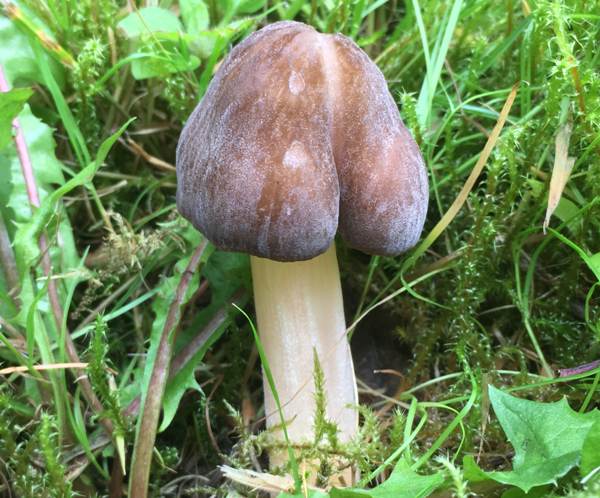
The velvetty cap and rose-flushed slightly velvetty stem of this medium-sized shield mushroom are its most distinctive macroscopic features; however, its scarcity and its preference for shaded woodland sites make it an all too infrequent find.
Distribution
A very rare find in Britain, this wood-rotting mushroom is a rare to occasional find in parts of mainland Europe from ScandinaviaI down to the Mediterranean and northern Spain.
Taxonomic history
This woodland mushroom was described in 1902 by Austrian mycologist Franz Xaver Rudolf von Höhnel (1852 - 1920) who gave it the binomial scientific name Pluteus roseipes by which it is known to this day.
As far as I can determine, Pluteus roseipes has just one synonym of: Pluteus leoninus var. roseipes (Höhn.) E. Ludw.
Etymology
Pluteus, the genus name, comes from Latin and literally means a protective fence or screen - a shield for example! The specific epithet roseipes simply means 'with a reddish stem'.
Identification guide
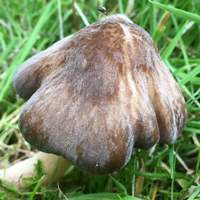 |
Cap
2 to 6cm across, campanulate, becoming convex and sometimes flattening but with a low broad umbo; densely velvety; dark grey-brown to reddish brown. Flesh white or brownish white. |
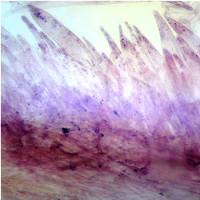 |
Pileipellis
A subcutis of more or less regular (parallel) elements overlaid with numerous protruding spindle-shaped cells.
|
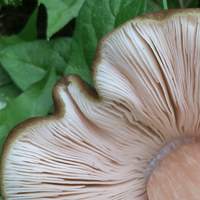
|
Gills
Free; crowded; white or greyish, turning pink as the spores mature. |
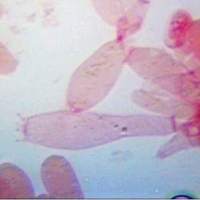 |
Basidia
Clavate, four spored, 6.5-8 x 5.5-7µm.
|
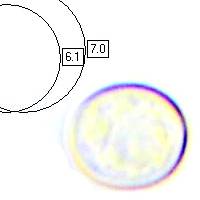 |
Spores
Subglobose, smooth, 6.5-8 x 5.5-7µm.
Spore print
Pale pink. |
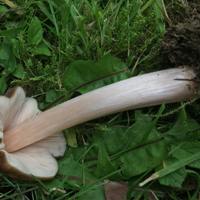
|
Stem
5 to 8cm long and 3 to 10mm diameter, cylindrical often wider at the base; longitudinally fibrillose and faintly flocculose/velvetty; whitish background flushed with pink; no stem ring. |
Odour/taste |
Not distinctive or smelling and tasting faintly fruity or, as some say, of radish! |
Habitat & Ecological role |
In common with other shield mushrooms, this is a wood-rotting (saprobic) fungus that favours very well rotted timber, most often buried in leaf litter. It is most often found in woodlands on alkaline soil. |
Season |
Fruiting from mid summer to late autumn. |
Similar species |
Pluteus cervinus is usually larger and has a smooth brown or fawn cap.
Pluteus leoninus is very similar except for its colours! (These two species are closely related.) |
Culinary Notes
Pluteus roseipes is not generally considered to be an edible species, and in view of its rarity this mushroom should not be gathered for eating.
Reference Sources
Fascinated by Fungi, 2nd Edition, Pat O'Reilly 2016, reprinted by Coch-y-bonddu Books in 2022.
Alfredo Justo, Andrew M. Minnis, Stefano Ghignone, Nelson Menolli Jr., Marina Capelari, Olivia Rodríguez, Ekaterina Malysheva, Marco Contu, Alfredo Vizzini (2011). 'Species recognition in Pluteus and Volvopluteus (Pluteaceae, Agaricales): morphology, geography and phylogeny'. Mycological Progress 10 (4): 453–479.
Orton, P.D. (1986). British Fungus Flora: Agarics and Boleti. Vol 4. Pluteaceae: Pluteus & Volvariella. Royal Botanic Garden: Edinburgh, Scotland.
Funga Nordica: 2nd edition 2012. Edited by Knudsen, H. & Vesterholt, J. ISBN 9788798396130
BMS List of English Names for Fungi
Dictionary of the Fungi; Paul M. Kirk, Paul F. Cannon, David W. Minter and J. A. Stalpers; CABI, 2008
Taxonomic history and synonym information on these pages is drawn from many sources but in particular from the British Mycological Society's GB Checklist of Fungi.
Acknowledgements
This page includes pictures kindly contributed by Simon Harding.
Top of page...
Fascinated by Fungi. Back by popular demand, Pat O'Reilly's best-selling 450-page hardback book is available now. The latest second edition was republished with a sparkling new cover design in September 2022 by Coch-y-Bonddu Books. Full details and copies are available from the publisher's online bookshop...